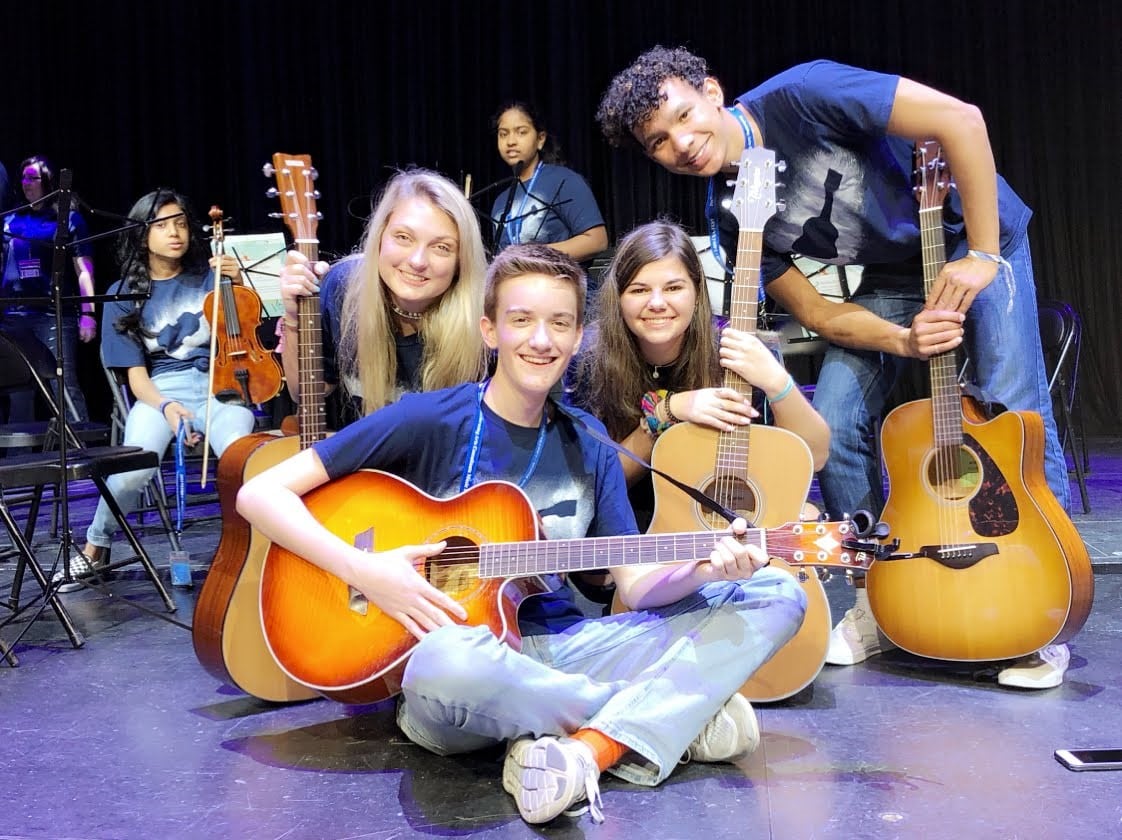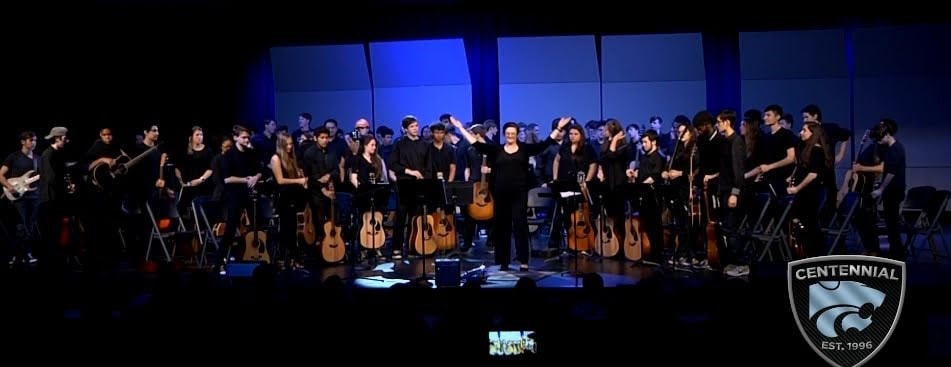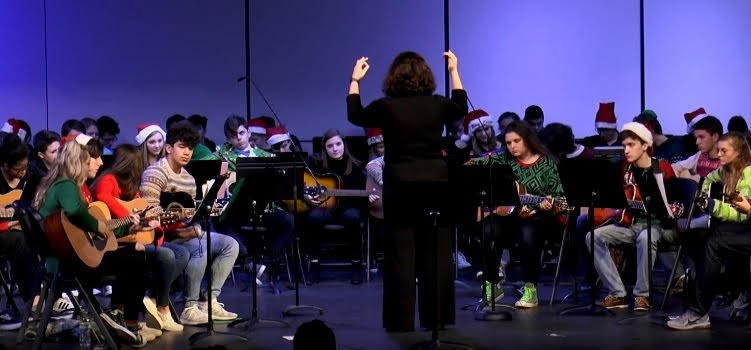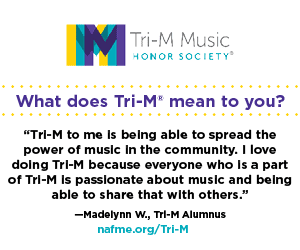/ News Posts / Guitar Class in the Volunteer State
Guitar Class in the Volunteer State
Number 31: The State of Tennessee
By Thomas Amoriello, Jr.
NAfME Council for Guitar Education Chair
Just south of Nashville, Allison Cowan created the Centennial High School Guitar Program in Franklin, Tennessee, which has grown to be one of the largest guitar programs in the state. She served as the Orchestra Representative on the Executive Committee of MTSBOA from 2015 to 2017. Currently, she is the Director of Orchestras for Centennial High School and the department head for Fine Arts at Centennial. She is a member of the Tennessee Music Education Association. In addition to NAfME she also is a member of the Middle Tennessee School Band and Orchestra Association and the American String Teachers Association.
Ms. Cowan has been teaching and conducting orchestral music for 17 years, in both the private setting and public school system. While she was private teaching, Mrs. Cowan also had a successful career in the legal and investigative fields. She left those fields to complete her music education degree and licensure at MTSU in 2007 and entered the public school sector. As a performer on her primary instrument (violin) she has performed with the Indianapolis Symphony, the Nashville Symphony, the Bath Camerata in Bath, England, the Nashville Philharmonic, and the DePauw Chamber Orchestra. In 2017, Mrs. Cowan was named as one of the 50 Directors Who Make a Difference by School Band and Orchestra Magazine.
The NAfME Council for Guitar Education would like to thank Ms. Cowan for sharing her story in guitar education.
Please tell us about your school and overall music program.
Centennial High School is in Franklin, Tennessee, which is a suburb of Nashville. Through our music program, students can participate in band, orchestra, choir, or guitar, all in differentiated levels. We employ three full-time music teachers at the school. All music groups at Centennial consistently receive superior ratings at the regional level and have been recognized at the state level at some point.
The students come from many different levels of experience before they reach Centennial. Some have spent lots of time in their middle school band and orchestra programs, while others did not have the opportunity to participate in certain music groups during middle school. Two of the three feeder schools have a rotating arts class where the students spend nine weeks receiving guitar instruction.
Please tell us about your own personal musical background growing up and your collegiate experience.
I took up the violin when I was nine and fell in love with string instruments. I originally went to college for violin performance, but many years later, I felt called to the classroom. I discovered that I am happiest when I am in the classroom.
My parents were very classically minded. We never listened to popular music in my household. We always listened to Bach, Beethoven, and Mozart, so I was inundated with symphonic music from a young age. In high school, I participated in my school orchestra, the area youth symphony, as well as regional and state honors orchestras. On top of that, I joined the band as a color guard member, and I played percussion and bass in concert band.
Guitar was not a part of my daily life. When I returned to college to get my teaching license, I was required to take method courses in every instrument EXCEPT guitar. It was not a requirement for the music education degree. How ironic that the one method class that wasn’t required was the one that I ended up needing the most.
How does the guitar family of instruments fit into your teaching?
I was comfortable with guitar because I already played string instruments. However, before I started the guitar program at Centennial, I had not played guitar on a regular basis. For the first year, I relied heavily on colleagues and my own music theory knowledge. Many times, I was working just one day ahead of the students.
“I realized that guitar was reaching a completely new part of the school population and was giving students a place within the school to call ‘home.’”
During that first year, my students fell in love with the instrument and asked if we could play a concert. We put together our first concert in the hallway of the school with 30 guitar players and an audience of more than 150 people. That’s when I realized we were on to something. Later that year, I polled my class and discovered that 85% of the students in guitar had NEVER been involved in their school music program. I realized that guitar was reaching a completely new part of the school population and was giving students a place within the school to call “home.” Research shows that students do better in school when they feel like they are a part of a community. Our guitar program has given that sense of community to a group of students who were falling through the cracks.
What obstacles did you face when you were first hired at your school? Now?
I was originally hired to start the orchestra program. Two years later, I was asked to teach two sections of Guitar 1. We didn’t have any instruments, method books, or music. All we had was a teacher willing to teach, an administration willing to give up some classroom space, and students who wanted to learn.
For the first semester, students brought their own guitars to use in class while we worked on grants and funding for some classroom instruments. On top of the lack of resources, I discovered that professional groups for guitar teachers were not abundant in Tennessee. Band, orchestra, and choir teachers all have multiple professional organizations who meet on a regular basis and provide mentoring to newer teachers. Classroom guitar teachers do not have such an extensive network. Private teachers were able to help me with individual technique, but they did not have as much experience teaching in the large ensemble environment. I had to figure out how to translate the teaching techniques used in band and orchestra to the guitar world. I reached out to any educator who had experience teaching classroom guitar to get ideas and practical advice.
Over time, we have been blessed with grants and donations so that we have a fully functional classroom environment. Students may use their own instruments, or they may use classroom instruments. Our administration and district have been very helpful in setting up the program so that we can differentiate instruction based on the students’ individual levels of playing. Therefore, I can have a student in the advanced level of guitar for multiple years, much like a student can participate in their band’s Wind Ensemble for multiple years.
What kind of classes related to the guitar do you teach?
I teach two sections of Beginning Guitar, one section of Intermediate Guitar, and one section of Advanced Guitar. On top of that, I teach two levels of orchestra every day.
What would you say to the non-guitarist music educator who is about to or interested in incorporating the guitar into their program?
Do not be intimidated by it. Use your knowledge as an educated musician to teach music to the students. It does not matter if the medium you are using to teach is a trumpet, violin, or a guitar.
Do not believe the myth that offering guitar will shrink the band, orchestra, or choir classes. Time and again, we have found that the students who get involved with the guitar programs are students who have never wanted to be involved in school music in the past. Band students love band. Choir students love choir. Guitar students love guitar. We have actually seen wonderful growth through our entire music program due to our unique offerings.
Use your imagination and creativity to create a positive musical experience for the students. The sky is the limit for what you want your music program to look like in your school. Every school is different. Use those differences to tailor your guitar program to fit your school.
Do you have any success stories you would like to share about students (musical and non-musical)?
One of my happiest moments came from a very unlikely student. I had a student who had been shuffled around through the foster care system for most of his life. He was a good child, but he couldn’t seem to stay away from bad choices, and his family life was not ideal. He was interested in guitar, but he had a lot of obstacles to overcome. He approached me before the winter concert to let me know that he wasn’t sure he could make it. He wasn’t sure he could get his guardians to give him a ride to the concert or that he had the correct clothes. I figured that I wouldn’t see him that night.
I was surprised when he appeared during warm-up time. He seemed embarrassed that he was wearing jeans instead of the “concert black” that we normally wear. I reassured him that I was just happy he had made it. He seemed very unsure of himself on the stage, so I took a couple of minutes during tuning to show him how performances worked. I pointed out that he could pick up a program from my podium to see what the concert order would be. He was amazed that his name appeared in the program. The lights of the stage seemed to dazzle him. I pointed out that our media department was videotaping the performance, and it would be available for him to send home to his family. He seemed in awe of everything he saw in front of him. Throughout the concert, I kept seeing his face staring up at me with a huge grin. Everything that was happening on stage seemed to bring him joy.
At the end of the concert, we received a standing ovation from 500 people. He looked so proud as he stood to acknowledge the resounding applause. It dawned on me that it may have been the first time in his life that he had seen so much approval of something he had done. That’s when I knew I had to advocate for guitar programs in the schools.
As veteran performers, most of us take for granted the feeling of being on stage and being a part of something successful. That night reminded me of all the students who have never had that experience and what an impact it can make on their lives.
What do you tell your talented students who are planning to pursue music or guitar studies in high school or college after they finish with you?
I have several students who have moved on to major in music. Being close to Nashville, we have a wealth of opportunities for students who wish to move forward in the music industry. I try my best to point students toward the educational opportunities that are geared toward helping them achieve their dreams.
When students leave my program, they should be able to read chord charts, tablature, standard notation, and even the Nashville Number System. If I am doing my job correctly, they should know their basic music theory, such as the major and minor scales and building chords. They should be able to play independently as well as with groups. I have the same expectations for my guitar students as I would for band, orchestra, or choir students who wish to pursue music at the college level.
Do you have any networking or advocacy tools that have worked for you in promoting your program that would help other educators?
I have been blessed to attend the Summer NAMM conference for the past couple of years. Through that conference, I have made friends with other classroom guitar teachers across the country and have been able to visit their districts to see what guitar education looks like in their schools. On top of that, many people are not aware that the American String Teacher Association has a guitar community, and they promote guitar educators through professional learning communities.
What kind of future do you see for guitar in music education in the Tennessee school system?
I would love to see guitar education take its place alongside band, choir, and orchestra in Tennessee. The guitar is a readily accessible instrument to all ages. It is the type of instrument that you can play at a gathering with friends or you can play on a concert stage. It is a staple of contemporary music, and most middle-class households own one. We, as educators, should be promoting guitar education because it is another vehicle by which to transmit music to future generations and get even more students involved in the arts.
What type of lesson plans have you done for your classes that may be unique?
I don’t think that I’ve really had a lot of unique lesson plans. One of the things that I love about the guitar classes is the organic nature of the class. In band, orchestra, and choir, the goal is to always “perfect” a piece of music. The composers and editors lay out every little detail to the music, and it is up to the ensemble to recreate what the composer wrote down. In the guitar world, students can look up a chord chart or use one provided by the teacher. However, I have fostered an environment where students can add their own ideas to the music. This lends itself very nicely to the students eventually writing for themselves. It is also quite wonderful to see the final product when the students present their own compositions or arrangements.
Do you participate in any musical performances or activities outside of your public school teaching duties?
I love to perform in pit orchestras whenever I get a chance. Further, I do freelance recording with area artists. I am also the music director for the Music City Youth Orchestra in Nashville. On top of that, I am active in the Middle Tennessee School Band and Orchestra Association as well as the American String Teachers Association.
Past “Guitar Class in 50 States” articles:
- Number 50: The Granite State (New Hampshire)
- Number 49: The Green Mountain State (Vermont)
- Number 48: The Mountain State (West Virginia)
- Number 47: The Hoosier State (Indiana)
- Number 46: The Mount Rushmore State (South Dakota)
- Number 45: The Pine Tree State (Maine)
- Number 44: The Badger State (Wisconsin)
- Number 43: The Constitution State (Connecticut)
- Number 42: The Evergreen State (Washington)
- Number 41: The Pelican State (Louisiana)
- Number 40: The Beaver State (Oregon)
- Number 39: The Equality State (Wyoming)
- Number 38: The Empire State (New York)
- Number 37: The Old Line State (Maryland)
- Number 36: The Centennial State (Colorado)
- Number 35: The Bay State (Massachusetts)
- Number 34: The Sooner State (Oklahoma)
- Number 33: The Prairie State (Illinois)
- Number 32: The Hawkeye State (Iowa)
- Number 30: The Palmetto State (South Carolina)
- Number 29: The Natural State (Arkansas)
- Number 28: The Tar Heel State (North Carolina)
- Number 27: The Magnolia State (Mississippi)
- Number 26: The Peace Garden State (North Dakota)
- Number 25: The Treasure State (Montana)
- Number 24: The First State (Delaware)
- Number 23: The Buckeye State (Ohio)
- Number 22: The Yellowhammer State (Alabama)
- Number 21: The Sunflower State (Kansas)
- Number 20: The Great Lakes State (Michigan)
- Number 19: The Lone Star State (Texas)
- Number 18: The Bluegrass State (Kentucky)
- Number 17: The Golden State (California)
- Number 16: The Show-Me State (Missouri)
- Number 15: The Keystone State (Pennsylvania)
- Number 14: The Last Frontier State (Alaska)
- Number 13: The Beehive State (Utah)
- Number 12: The Peach State (Georgia)
- Number 11: The Cornhusker State (Nebraska)
- Number 10: The Gem State (Idaho)
- Number 9: The Old Dominion (Virginia)
- Number 8: The Aloha State (Hawaii)
- Number 7: The Land of Enchantment (New Mexico)
- Number 6: The Sunshine State (Florida)
- Number 5: The Grand Canyon State (Arizona)
- Number 4: The Ocean State (Rhode Island)
- Number 3: The North Star State (Minnesota)
- Number 2: The Silver State (Nevada)
- Number 1: The Garden State (New Jersey)
About the author:
 Thomas Amoriello Jr. serves as the chair on the NAfME Council for Guitar Education and is also the former Chairperson for the New Jersey Music Education Association. Tom has taught guitar classes for the Flemington Raritan School District in Flemington, New Jersey, since 2005 and was also an adjunct guitar instructor at Cumberland County College, New Jersey, for five years. He has earned a Master of Music Degree in Classical Guitar Performance from Shenandoah Conservatory and a Bachelor of Arts in Music from Rowan University. He is the author of the children’s picture books A Journey to Guitarland with Maestro Armadillo and Ukulele Sam Strums in the Sand, both available from Black Rose Writing. He recently made a heavy metal recording with a stellar roster of musicians including former members of Black Sabbath, Whitesnake, Ozzy Osbourne, Yngwie J. Malmsteen’s Rising Force, and Dio that was released on H42 Records of Hamburg, Germany. The record released on 12-inch vinyl and digital platforms has received favorable reviews in many European rock magazines and appeared on the 2018 Top 15 Metal Albums list by Los Angeles KNAC Radio (Contributor Dr. Metal). Visit thomasamoriello.com for more information.
Thomas Amoriello Jr. serves as the chair on the NAfME Council for Guitar Education and is also the former Chairperson for the New Jersey Music Education Association. Tom has taught guitar classes for the Flemington Raritan School District in Flemington, New Jersey, since 2005 and was also an adjunct guitar instructor at Cumberland County College, New Jersey, for five years. He has earned a Master of Music Degree in Classical Guitar Performance from Shenandoah Conservatory and a Bachelor of Arts in Music from Rowan University. He is the author of the children’s picture books A Journey to Guitarland with Maestro Armadillo and Ukulele Sam Strums in the Sand, both available from Black Rose Writing. He recently made a heavy metal recording with a stellar roster of musicians including former members of Black Sabbath, Whitesnake, Ozzy Osbourne, Yngwie J. Malmsteen’s Rising Force, and Dio that was released on H42 Records of Hamburg, Germany. The record released on 12-inch vinyl and digital platforms has received favorable reviews in many European rock magazines and appeared on the 2018 Top 15 Metal Albums list by Los Angeles KNAC Radio (Contributor Dr. Metal). Visit thomasamoriello.com for more information.
Interested in reprinting this article? Please review the reprint guidelines.
The National Association for Music Education (NAfME) provides a number of forums for the sharing of information and opinion, including blogs and postings on our website, articles and columns in our magazines and journals, and postings to our Amplify member portal. Unless specifically noted, the views expressed in these media do not necessarily represent the policy or views of the Association, its officers, or its employees.
Catherina Hurlburt, Marketing Communications Manager. October 25, 2019. © National Association for Music Education (NAfME.org)
Published Date
October 25, 2019
Category
- Ensembles
Copyright
October 25, 2019. © National Association for Music Education (NAfME.org)







